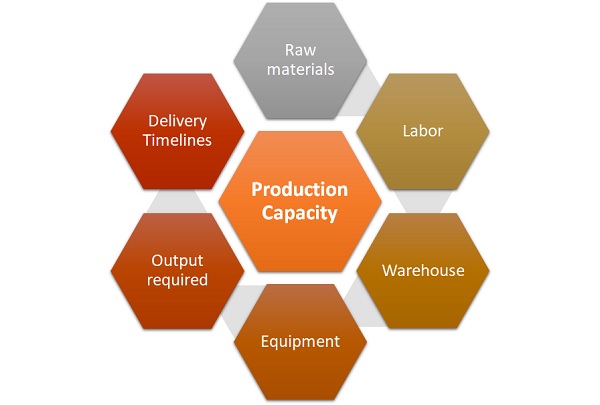- Business Concepts ›
- Operations and Supply Chain ›
- Production Capacity
Production Capacity
This article explains definition, importance, factors & example of Production Capacity from operations perspective.
Production Capacity Definition
Production capacity is the output a business process can produce in a given time with finite resources under expected and normal conditions. Production Capacity is like the maximum potential of a business to produce finished goods with available budget and raw materials or inputs. It can be calculated over a period of time like a week, days, or months even.
Product Capacity is usually referred to in units of finished goods produced by it. e.g. 5000 chairs in a month or 50000 clips in a week etc.
Production Capacity Importance
Production Capacity is very important while designing a business process. It determines how much production a business anticipates to be sold for next few years or months. According to that, one buys raw materials, equipment and other inputs so that the production capacity meets the demand. if a business invests too much into production capacity and the demand in the market is less then a lot of produced inventory can go waste.
If the business doesn't use the planned capacity, then the business is losing the money it invested in building the capacity. There are lot of factors which determine the production capacity.

Production Capacity Factors
It is how you manage your raw materials, employees, time and storage in a efficient way to equalize demand. Decisions in such cases takes time and depends upon a lot of factors such as:
1. Raw materials which would be used to produce the finished goods
2. Labor which will be working to support the machinery and make the products
3. Warehouse for Storing the intermediate or finished goods to make sure that the inventory is well maintained.
4. Equipment and Machinery including their maintenance and downtime
5. Scheduling e.g. 8 hours a day or 24 hrs a day
6. Business Conditions
7. Delivery Timeliness
8. Required Output
Production Capacity Formula
The average annual production capacity is defined as:
(Production capacity at the beginning of the year) + (Average annual capacity of the equipment introduced during the year) – (Average annual capacity of the equipment removed during the year).
This enables companies to calculate the production capacity.
Example of Production Capacity
Assuming a factory produces beverages in 500 ml bottles. Now there are two types of machines in the factory. The first set of machines make glass bottles and another set of machines make the drinks and fills in the bottle.
Both these machines need to work in synchronization. If there is not enough glass bottles, beverage will go waste and vice versa.
Let us assume machines can run for 15 hours a day.
the first machine can make 10 bottles a minute. In 15 hours it can make 15x60x10 bottles which 9000 but the second machine can make only 1000 ml beverage in 1 minute so in 15 hours it can make 1000ml x 15x60 which is 900000 ml of beverage.
Now for a 500 ml bottle with 900000 ml, the business can fill 1800 bottles only which can defined as the production capacity but now business has to decide either to reduce the bottles making capacity or increase the beverage making capacity.
Also the market demand needs to be judged to make sure how to finetune the production capacity.
Hence, this concludes the definition of Production Capacity along with its overview.
This article has been researched & authored by the Business Concepts Team which comprises of MBA students, management professionals, and industry experts. It has been reviewed & published by the MBA Skool Team. The content on MBA Skool has been created for educational & academic purpose only.
Browse the definition and meaning of more similar terms. The Management Dictionary covers over 1800 business concepts from 5 categories.
Continue Reading:
What is MBA Skool?About Us
MBA Skool is a Knowledge Resource for Management Students, Aspirants & Professionals.
Business Courses
Quizzes & Skills
Quizzes test your expertise in business and Skill tests evaluate your management traits
Related Content
All Business Sections
Write for Us